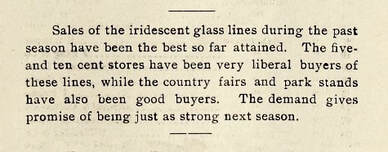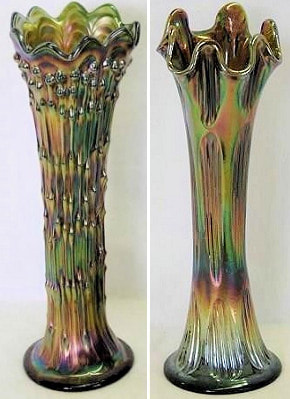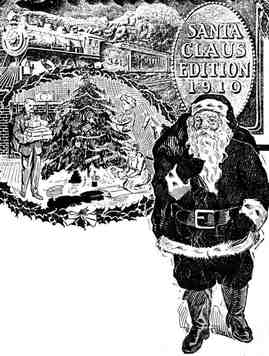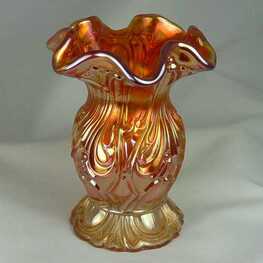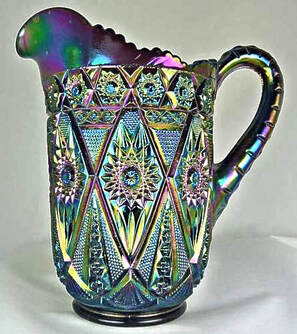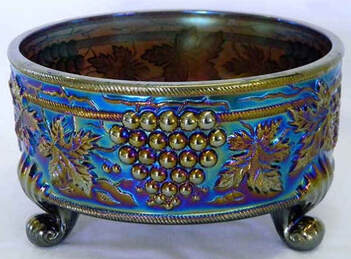A Snapshot of 1910
|
The year was 1910 - it was a good year for Carnival Glass. It was popular and well established (having been introduced a couple of years earlier) and was selling profitably, as this August 1910 issue of the Crockery & Glass Journal explained. Extract from August, 1910 Crockery & Glass Journal.
Note the reference to the importance of the "five and ten cents stores" as buyers of Carnival Glass. There are many contemporaneous references to these stores, which were very much part of the distribution chain between the glassmakers and the buying public. The stores offered a wide assortment of items for personal and household use, at the fixed prices of 5c or 10c. We have written about them and other Carnival Glass sales outlets, including ads from the time, in our feature article, Sell Me Some Carnival Glass.
The Lewis Hine image on the right was also from 1910 – and the caption of this fascinating image was “Where the boys spend their money”. A gallery seat at Havlin’s motion picture theatre in St. Louis cost 10 cents, which was the same price as the vases shown in the 1910 ad below, left, from the Oregon Daily Journal. The vases in the ad were advertised as being worth 25 cents – the same price as a better seat in the movie theatre. The 1910 ad featured items that were being sold in a large store’s "Bargain Basement", and just as with the "five and ten cents stores", such sales outlets were a key part of the way items were marketed and sold at the time. The Bargain |
Lewis Hine, 1910, courtesy Library of Congress, St Louis, MO.
|
Basement was the brain-child of Mr Harry Selfridge (famous for his great London department store, Selfridges), who invented the concept as early as 1885, when he worked at the Marshall Field Department store in Chicago. You can read all about it here: The Bargain Basement.
|
The vase on the right of the Oregon Daily ad is readily identified as Fenton’s Diamond and Rib, but the other is not so clearly illustrated. In the centre below, you can see what appears to be the identical illustration in a November 1910 Butler Brothers wholesale ad, and it has clearer reproduction. We feel the second vase was intended to be Fenton’s April Showers. |
Left, April Showers and right, Diamond and Rib (both Fenton). Courtesy Seeck Auctions.
|
|
The November 1910 Butler Brothers catalogue was called the “Santa Claus Edition”, shown on the right.
It was full of gift ideas, with the catalogue proclaiming that “every novelty is in place, the gaps are all filled, stocks are mountainous. Tomorrow the ‘rush’ begins. As soon as this book is delivered a flood of orders will pour in to our four houses from merchants in every township in the United States”. It was up-beat. And there was plenty of Carnival Glass to be had! Of the main Carnival producers at the time, there was lots of Northwood and Fenton, plus a good amount of Dugan – but not much Imperial or Millersburg. From Northwood we see Grape and Cable, in many shapes and sizes, such as this "Vineland" Dining Set, offered in "iridescent amethyst and green".
Smilarly, Fenton showed a wide variety of iridescent glass, often described as “Venetian”, as in the ad below. It's also interesting to see Fenton's use of the "three-in-one" edge (on the bowl, top row, on the left), and the tight "continuous crimp" edge (on the bowl, bottom row, right). The dawning of 1910 also brought the glitter of Millersburg’s signature Radium glass, and the trade press was full of positive reports of their new glass, with the exceptionally mirror-shiny iridescent effect that characterises some of their Carnival output. |
Above: Northwood Grape and Cable butter, green.
Below: Fenton Peacock Tail comport, blue. Both Seeck Auctions. |
|
On the left is a Millersburg Holly Whirl bowl in marigold, with a brilliantly beautiful radium finish. Shown above is a report from the Crockery & Glass Journal in January 1910 - it typifies the sort of reception that John Fenton was getting for his new glass company.
Sadly, however, 1910 turned out to be pivotal for Millersburg; they were expanding rapidly and perhaps it was too rapid, for as it turned out, in the following year they filed for bankruptcy. We have charted the very short-lived life of Millersburg Glass Co. as recorded in press reports at the time. Here is the Millersburg Story: Millersburg - the Rise and Fall. |
|
Imperial, on the other hand, were doing well in 1910, but their “Wonder Assortment” (below) was the only ad for their iridescent glass in the entire “Santa Claus” Butler Brothers 1910 catalogue, although there were many other ads for Imperial’s crystal glass.
|
Rococo vase, marigold.
|
However, Imperial was beginning to push their iridescent glass elsewhere in the trade press. Clearly, it was already well-established in the line, towards the end of 1910 when there was a series of full page ads for their Carnival Glass, placed by their New York Representative, Cox & Lafferty. The selections being advertised had a wide range of patterns, shapes and colours, and they were made up and sent out directly from Imperial's factory.
|
Imperial described these offerings as "something NEW in iridescent glassware, totally unlike any of its predecessors. The basic glass is new - the metallic lustre effects new." We show these Cox & Lafferty ads in great detail here: Sell me some Imperial Glass!
|
Left: a Cox & Lafferty ad in The Pottery, Glass & Brass Salesman, Oct. 1910. Below: one of the pieces shown in the ad, a Diamond Lace pitcher in a colour that Imperial called "Azur" - glass "with green, blue, red and yellow iridescent colors ... of very striking appearance." |
Meanwhile, Dugan’s offerings in 1910 included decorated (enamelled) bowls as well as peach opalescent Carnival.
|
Above: three decorated (enamelled) bowls from Dugan:
Left to right they are, Lily of the Valley (on a Stippled Flowers bowl), Forget-me-Not (on a Stippled Petals bowl) and Roses (on a Cherries bowl). The ad described them as having “pearl edges” – this was peach opalescent glass. It’s also interesting that the ad stated “Decorations burnt in, will not wash off”, indicating that the enamelling was “fired on” and should be permanent. |
Lily of the Valley enamelled decoration on a Stippled Petals
peach opal dome footed bowl. Seeck Auctions. |
There is an interesting story about how Orphan Annie got its name, here: Orphan Annie visits the Fairground
The notion of gift-boxing glassware feels very modern, yet here is a splendidly presented and gift-boxed, Northwood, Grape and Cable fernery – complete with its “white enamelled removable lining”.
|
Water sets also made quite an impression in 1910.
Butterfly and Fern pitcher, blue.
|
In the ad on the left we see Fenton’s Butterfly and Fern and Panelled Dandelion water sets, and in the ad on the right is Northwood’s Grape and Cable. Note that marigold Carnival was referred to as “sunset iridescent” and “golden sunset … iridescent”.
|
|
The block ad from 1910 (below) features three bowls each from three different makers and it is most interesting to study. At the top are three Millersburg bowls – Primrose, Nesting Swan and Whirling Leaves. The ad stated that there were four patterns, so one of them was not illustrated. In the middle are three Fenton pieces – Vintage, Little Flowers and Feathered Serpent. The ad referred to "6 shapes, average 9¾in." (inches) - so presumably there were different shapes of the same pattern in each assortment. At the bottom are three Dugan items – Smooth Rays with the Jewelled Heart exterior showing through, Petal and Fan (also with the Jewelled Heart exterior showing through) and Ski Star – the ad describes the Dugan pieces as having “smooth pearl edges and undersurface” so that would have been peach opalescent glass. The Millersburg bowls were shipped in a "tierce", that is, a large sized barrel, which contained 6 dozen (72 bowls) per tierce. The Fenton and Dugan bowls were shipped in smaller barrels containing 2 dozen (24 bowls) per barrel. The comparative cost of the three sets of bowls is also interesting.
Even allowing for the slight difference in size, it’s clear that the slightly smaller Millersburg bowls were relatively cheap compared to the others. And bear in mind that Millersburg went to the considerable additional expense of using moulds with specific exterior patterns that were matched up with the main interior patterns *. We know that the founder of Millersburg Glass, John W Fenton eventually overreached himself, and the business failed **; perhaps their pricing policies played a part. Right: Petal and Fan large bowl, peach opal.
Seeck Auctions. |
* Millersburg's amazing exterior patterns are complex designs and must have required laborious and very skilful execution by the designer and mouldmaker. They can be hard to identify, but Glen's brilliant artistic skill has made this an easy task with her exquisite line drawings of each one.
See them all here: Millersburg's Masterpieces
** We gave a link to the Millersburg Story earlier in our review of 1910. Here it is again, for reference: Millersburg - the Rise and Fall.
See them all here: Millersburg's Masterpieces
** We gave a link to the Millersburg Story earlier in our review of 1910. Here it is again, for reference: Millersburg - the Rise and Fall.
